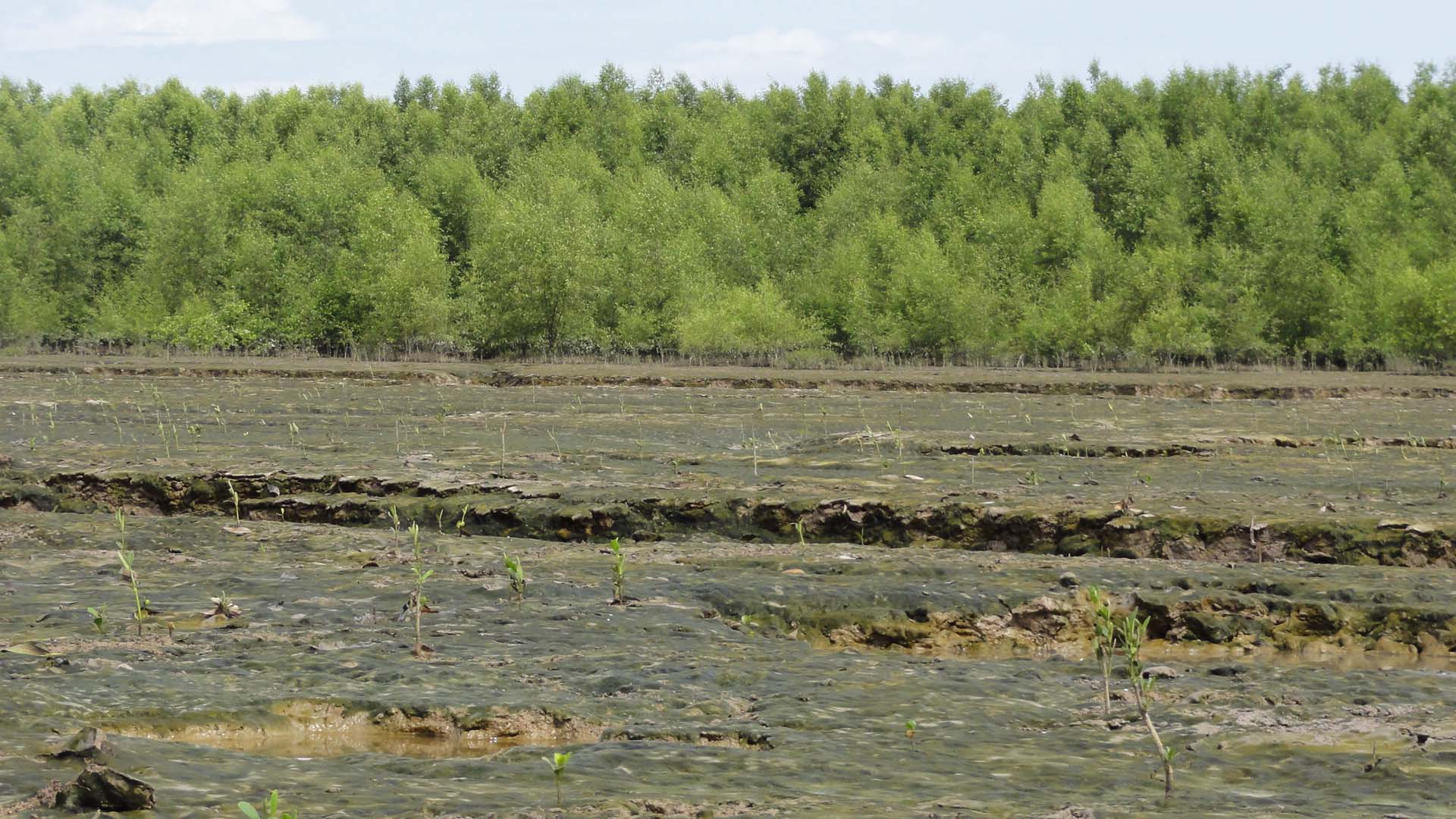Copyright : Laboratoire LEMAR- 2018
French Guiana
The French Guiana coast, 80% covered by mangroves, is subject to intense hydro-morpho-sedimentary dynamics under the direct influence of the massive discharge of suspended sediments from the Amazon River. The development of Guyanese mangroves, which represent 70% of French mangroves, depends on the dynamics of the mud banks transiting along the coast from East to West from the Amazon to the Orinoco, alternating periods of several years of coastal advance and retreat: each part of the coast is therefore subject to an alternation of siltation (passage of a bank) and erosion (phase called “interbanc”). Mangroves only develop cyclically through successive phases: colonization of bare mud as soon as it is sufficiently consolidated, extension of the pioneering mangrove, maturity of the forest then uprooting of trees and regression of the mangrove as a result of substrate erosion. It is therefore a very dynamic ecosystem, in constant evolution. This unstable and short-lived ecosystem is paradoxically characterized by high productivity and a high standing biomass (up to 350 t/ha). At each phase of erosion, very large quantities of plant debris, and more generally organic matter, are then exported to the waters and adjacent bottoms, which in turn feed the biological productivity of the Guyana coastal zone. The mangrove swamp of Guyana is one of the best preserved in the world, and its particular dynamics makes it a unique model for studying the natural resilience of a coastal ecosystem: in this case, it is the ability of Guyanese mangroves to adapt to the rapid variations in sedimentary processes that condition the structure and functioning of all compartments of the ecosystem.
LEMAR’s work in French Guiana aims to:
- Construction of a detailed carbon footprint for mangroves, taking into account stocks and flows between different reservoirs (air-forest-sediment-water), in order to improve the current carbon inventory of coastal systems.
- Identification of the role of benthic biodiversity (microalgae and benthic invertebrates) and particularly the impact of bioturbation on carbon transformation processes in the sediment matrix and at sediment-water-air interfaces.
- Characterization of the fate of organic matter in terms of export to adjacent ecosystems and transfer to local food webs, through the use of isotopic and lipid biomarkers.
- Characterization of the food web structure for different mangrove facies and ages, assessment of the functional importance of habitat for higher trophic levels.
- Participation in the transfer of knowledge to the school-age public through the training of secondary school teachers or the implementation of educational workshops in consultation with scientific mediation teams.
Past projects:
- Project BIOMANGO (BIOdiversity and ecosystem functioning of MANgroves in French Guiana: prospects for ecOsystem management in the Amazonian system), P.I.: E. Michaud (2013-2016)
- Project MANGROVE-LAB (Study of crab activity on biogeochemical functioning of Guianese mangroves: approach in mesocosms), P.I. : E. Michaud (2015)
- Project MAGUY (Benthic structural and functionning biodiversity within mangroves), porteuse: E. Michaud (2015)
- Projet CARMAC (Origin, transport and fate of total organic carbon along the mangrove dominated coastal forest of French Guiana), P.I. : R. Ray (2015-2017)
- Project Mancoco (Characterization of dissolved organic matter from mangroves to adjacent guianese waters), LEMAR team leader: E. Michaud) (2015)
- Project Prisme (Oil contamination impact on Guianese mangroves and associated benthic species), LEMAR team leader: E. Michaud (2015)
Ongoing projects
- BIOGEOMORPHO project (Evaluation of the biogeomorphology of mangrove ecosystems using drones), P.I.: E. Michaud (2018)
- DYCOCOCO project (Study of carbon dynamics in coastal waters of French Guiana), team leader for LEMAR: E. Michaud (2017-2019)
- Mangrove Bioindicators Project (Study of the biological functioning of mangrove sediments with a view to developing a bio-indicator for monitoring Transitional Water Bodies and the Overseas Coastal Water Body), team leader for LEMAR : E. Michaud (2017-2018)
- GDR LIGA (Coastal Guyana under Amazonian influence: dynamics and vulnerabilities of communities and ecosystems), P.I.s: E. Michaud & A. Gardel (2018-2021)







